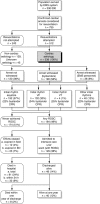Long term outcome after out-of-hospital cardiac arrest with physician staffed emergency medical services: the Utstein style applied to a midsized urban/suburban area
- PMID: 10573491
- PMCID: PMC1729199
- DOI: 10.1136/hrt.82.6.674
Long term outcome after out-of-hospital cardiac arrest with physician staffed emergency medical services: the Utstein style applied to a midsized urban/suburban area
Abstract
Objective: To test the effect of a physician staffed advanced cardiac life support (ALS) system on patient outcome following out-of-hospital cardiac arrest.
Design: Observational study.
Setting: Two tier basic life support (BLS) and physician staffed ALS services in the midsized urban/suburban area of Heidelberg, Germany.
Patients: All patients suffering out-of-hospital cardiac arrest of cardiac aetiology between January 1992 and December 1994 and who were covered by ALS services.
Interventions: Physician staffed ALS services.
Main outcome measures: Return of spontaneous circulation, hospital discharge, and one year survival, according to the Utstein style.
Results: Of 330 000 inhabitants, 755 suffered from cardiac arrest covered by the Heidelberg ALS services. In 512 patients, cardiopulmonary resuscitation had been initiated. Of 338 patients with cardiac aetiology, return of spontaneous circulation was achieved in 164 patients (49%), 48 (14%) were discharged alive, and 40 (12%) were alive one year later; most of these patients showed good neurological outcome. Thus, 4.85 patients with cardiac aetiology were saved by the ALS services and discharged alive per 100 000 inhabitants a year. Ventricular fibrillation or tachycardia was detected in 106 patients (31%), other cardiac rhythms in 40 (12%), and asystole in 192 (57%). Hospital discharge rates (and one year survival) in these subgroups were 34.0% (29.2%), 12.5% (7.5%), and 3.6% (3.1%), respectively. Discharge rates increased if cardiac arrest was witnessed (bystander, 20.0%; BLS/ALS personnel, 21.4%; non-witnessed arrest, 3.3%; p < 0.01), and if the time period between the alarm and the arrival of the ALS unit was four minutes or less (</= 4 minutes, 30.6%; 4-8 minutes, 10.4%; > 8 minutes, 8. 1%; p < 0.001). In 69 patients with bystander witnessed cardiac arrest with ventricular fibrillation, the discharge rate was 37.7%; 21 patients were alive after one year.
Conclusions: A two tier BLS and physician staffed ALS system is associated with good long term outcome of patients suffering from out-of-hospital cardiac arrest of cardiac aetiology in a midsized urban/suburban area. Further studies, however, are required to assess whether having a physician in the ALS unit is an independent determinant for improved long term outcome.
Figures



References
Publication types
MeSH terms
LinkOut - more resources
Full Text Sources
Other Literature Sources
Medical
Miscellaneous
